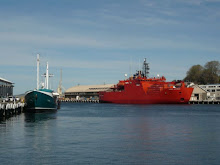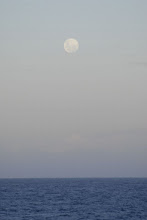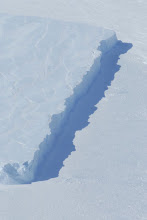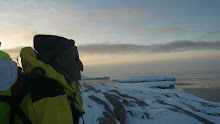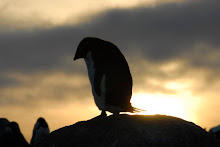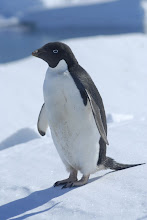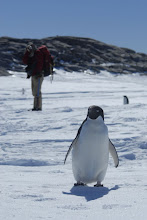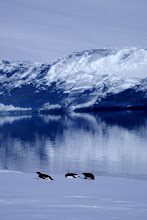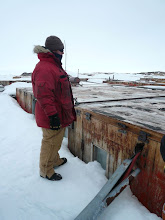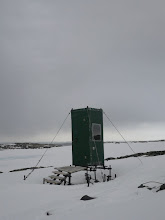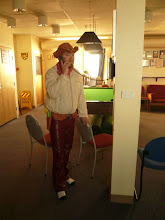 Field training, as I mentioned, prepares us for travelling off station on jollies by teaching us “vital skills, essential for travel within Antarctica”. Most of what we were taught is common sense or skills most people should already know (navigating by compass, how to set up a tent, how to light a gas stove), but as usual it seems to be more about making us accountability for our actions than anything. Having said this we did learn some interesting things; things it is pretty hard to learn elsewhere, like ice-walking with instep cramp-ons, bivvying in a near blizzard, and sea-ice travel.
Field training, as I mentioned, prepares us for travelling off station on jollies by teaching us “vital skills, essential for travel within Antarctica”. Most of what we were taught is common sense or skills most people should already know (navigating by compass, how to set up a tent, how to light a gas stove), but as usual it seems to be more about making us accountability for our actions than anything. Having said this we did learn some interesting things; things it is pretty hard to learn elsewhere, like ice-walking with instep cramp-ons, bivvying in a near blizzard, and sea-ice travel.  As tame as that slope looks, its hard to explain just how slippery a hill of ice really is. I actually took a tumble or two, which may or may not have been intentional.
As tame as that slope looks, its hard to explain just how slippery a hill of ice really is. I actually took a tumble or two, which may or may not have been intentional.  Our main mode of transport for jollies is quad bikes. They work surprisingly well on snow, and absolutely terribly on ice… what a surprise. But that doesn’t mean they aren’t still great fun.
Our main mode of transport for jollies is quad bikes. They work surprisingly well on snow, and absolutely terribly on ice… what a surprise. But that doesn’t mean they aren’t still great fun.  Here we are travelling on a large piece of sea-ice (above). The recommendations for ice thickness in terms of sea-ice travel are 20cms for pedestrian travel, 40cms for quad bikes, and 60cms for a hagglunds. I tend to err on the side of caution with these figures, maybe its just me, but I like the concept of self-preservation.
Here we are travelling on a large piece of sea-ice (above). The recommendations for ice thickness in terms of sea-ice travel are 20cms for pedestrian travel, 40cms for quad bikes, and 60cms for a hagglunds. I tend to err on the side of caution with these figures, maybe its just me, but I like the concept of self-preservation.  We hand-drill down to test sea-ice thickness every few hundred meters.
We hand-drill down to test sea-ice thickness every few hundred meters.Our first night of training was spent at the abandoned American station Wilkes. It is just across the bay from Casey (3kms directly) and was abandoned because it is basically situated in the middle of a very large blizz-tail.
 Removing the snow that built up around the buildings just got too much so they gave it to the Australians, and we relocated it. Wilkes is an interesting time warp because all that’s left is the tops of the old buildings (buried under snow) and lots of random ‘junk’ like broken wooden crates, rusty nails, old metal pipes, which must be left in place since the whole area is now heritage listed.
Removing the snow that built up around the buildings just got too much so they gave it to the Australians, and we relocated it. Wilkes is an interesting time warp because all that’s left is the tops of the old buildings (buried under snow) and lots of random ‘junk’ like broken wooden crates, rusty nails, old metal pipes, which must be left in place since the whole area is now heritage listed.  However the main reason people visit Wilkes from Casey is to stay at the “Wilkes Hilton”. This is an authentic Antarctic building (built in the early 50’s), which contains the ONLY wood fire on Australian/Antarctic land. Of the 3 or 4 ‘field huts’ people from Casey can visit on jollies this is the most luxurious… hence the name.
However the main reason people visit Wilkes from Casey is to stay at the “Wilkes Hilton”. This is an authentic Antarctic building (built in the early 50’s), which contains the ONLY wood fire on Australian/Antarctic land. Of the 3 or 4 ‘field huts’ people from Casey can visit on jollies this is the most luxurious… hence the name. 
 Despite the 4 beds inside however, we bivvied out this night as part of our training. A bivvy bag consists of a windproof sack (a little bigger than a sleeping bag) with a foam mat rolled up inside. The idea is that if you get stuck in the field and the weather closes in, it may be safer to stay put and wait for help or the weather to clear, which may be 2 or 3 days... Bivvying is a warm and dry alternative to standing around in a blizzard.
Despite the 4 beds inside however, we bivvied out this night as part of our training. A bivvy bag consists of a windproof sack (a little bigger than a sleeping bag) with a foam mat rolled up inside. The idea is that if you get stuck in the field and the weather closes in, it may be safer to stay put and wait for help or the weather to clear, which may be 2 or 3 days... Bivvying is a warm and dry alternative to standing around in a blizzard.  That techni-coloured blob is actually one of our plumbers, Wayne, inside his bivvy.
That techni-coloured blob is actually one of our plumbers, Wayne, inside his bivvy. 
 When you bivvy everything goes in. There isnt too much room, and its hard to organise things in a stong wind, but once youre sorted its ok. Of course, where every other field training party had warm nights and no wind for their bivvying, we had 25-30 knots and blowing snow. But despite all this I slept quite well that night, and had to be woken up the next morning.
When you bivvy everything goes in. There isnt too much room, and its hard to organise things in a stong wind, but once youre sorted its ok. Of course, where every other field training party had warm nights and no wind for their bivvying, we had 25-30 knots and blowing snow. But despite all this I slept quite well that night, and had to be woken up the next morning. The next day we ate lunch in what is intelligently called a mega-bivvy (above). In 15 knot winds 5 of us climbed inside and got very warm very quickly. This too is simply a windproof sack with no structure to it, but within 5 minutes our own body-warmth had expanded the bivvy so that we had plenty of room inside.
The next day we ate lunch in what is intelligently called a mega-bivvy (above). In 15 knot winds 5 of us climbed inside and got very warm very quickly. This too is simply a windproof sack with no structure to it, but within 5 minutes our own body-warmth had expanded the bivvy so that we had plenty of room inside. 
Inside the van. Each hut has a few LPG Gas cylinders attached to it for cooking and heating, and most have a sink for waching. They all have a small supply of food as well, and are designed as emergency shelter incase the weather doesnt allow you to get back to station for a few days.
 Our second night was spent on the Mitchell Peninsula, 15kms or so from station as the albatross fly’s. The infrastructure here consists of a small caravan type hut, and three polar pyramids. Polar pyramids are more or less bomb proof tents… at least blizzard proof… and are designed such that they become more sturdy in stronger winds.
Our second night was spent on the Mitchell Peninsula, 15kms or so from station as the albatross fly’s. The infrastructure here consists of a small caravan type hut, and three polar pyramids. Polar pyramids are more or less bomb proof tents… at least blizzard proof… and are designed such that they become more sturdy in stronger winds. Sleeping in these pyramids with the sound of light snow falling outside was the closest ive felt to home and camping since arriving.
Sleeping in these pyramids with the sound of light snow falling outside was the closest ive felt to home and camping since arriving.Another part of training was toilet training. Yes, it sometimes feels like we’re babies here… not trusted to sit the right way on a toilet seat for fear that we might get caught in a blizzard doing so… but ALL our grey water (number one’s, number two’s and dish washing water) must be collected and brought back to station during a jolly. I don’t have too many photos of this sorry, but what I do have is a photo or two of some of the most spectacular toilets ive ever seen in my life (see photos on the side). How many of you can tell me you gaze at an Antarctic coastline while going about your business?
 We covered quite a few other things in training, but for fear of boring you to tears I might once again say adios. Until next time.
We covered quite a few other things in training, but for fear of boring you to tears I might once again say adios. Until next time. For example driving a hägglunds.
For example driving a hägglunds. Aside from actual work in the office and meteorological goings on, I am also part of the hydroponics team. The plants need daily maintenance (topping up water, nutrient levels, regulating pH levels, harvesting etc) so we have created a roster for whoever is interested: I spend maybe 30mins to 1 hour in there every Friday.
Aside from actual work in the office and meteorological goings on, I am also part of the hydroponics team. The plants need daily maintenance (topping up water, nutrient levels, regulating pH levels, harvesting etc) so we have created a roster for whoever is interested: I spend maybe 30mins to 1 hour in there every Friday.

 As you may be able to see the rooms are quite small, but we still manage to grow a good variety of things. We have plenty of herbs growing (thyme, parsley, dill, sage, and more) as well as lettuce, rocket, tomatoes, and cucumbers. The UV lights in the two rooms are on timers to simulate daylight and night-time. Im afraid to say its not exactly 100% organic though...
As you may be able to see the rooms are quite small, but we still manage to grow a good variety of things. We have plenty of herbs growing (thyme, parsley, dill, sage, and more) as well as lettuce, rocket, tomatoes, and cucumbers. The UV lights in the two rooms are on timers to simulate daylight and night-time. Im afraid to say its not exactly 100% organic though... 
 As I think I already mentioned, we have a small brewery here too (these are for you Danny boy, congrats on little bubba Olivier :) We make many varieties of beer, some of which aren’t too bad at all, and the best of which are the honey beer and the alcoholic ginger beer. And what good is a brewery without a bar?
As I think I already mentioned, we have a small brewery here too (these are for you Danny boy, congrats on little bubba Olivier :) We make many varieties of beer, some of which aren’t too bad at all, and the best of which are the honey beer and the alcoholic ginger beer. And what good is a brewery without a bar? Ive also added some pictures of some of the other facilities in the Redshed, since quite a bit of my spare time is also spent with these. Table tennis, air hockey, pool table and darts board. There is also a spa and sauna in the Tank House, and various pieces of gym equipment.
Ive also added some pictures of some of the other facilities in the Redshed, since quite a bit of my spare time is also spent with these. Table tennis, air hockey, pool table and darts board. There is also a spa and sauna in the Tank House, and various pieces of gym equipment.
 Since I have now been field trained (photos to come soon), I am allowed to explore the ‘extended station limits’ on my own, providing I take a field pack and a radio, and have permission to do so from the Station Leader (SL). This means I am allowed to go to places like Shirley Island on my own and also the ‘recreation area’, which is an area about 2km by 2km adjacent to the station (green boundary on the map below… dad, right click on the image and ‘save as’, then you can open it and zoom in, hehe). Those of us in the fire team must find someone to take our place whenever we leave station limits (yellow boundary on the map), and as fire chief this means one of the two deputies… you cant have just any old person as fire chief :)
Since I have now been field trained (photos to come soon), I am allowed to explore the ‘extended station limits’ on my own, providing I take a field pack and a radio, and have permission to do so from the Station Leader (SL). This means I am allowed to go to places like Shirley Island on my own and also the ‘recreation area’, which is an area about 2km by 2km adjacent to the station (green boundary on the map below… dad, right click on the image and ‘save as’, then you can open it and zoom in, hehe). Those of us in the fire team must find someone to take our place whenever we leave station limits (yellow boundary on the map), and as fire chief this means one of the two deputies… you cant have just any old person as fire chief :) The photos below were taken within the extended station limits area, so theres still some pretty cool things to see in the station rec area.
The photos below were taken within the extended station limits area, so theres still some pretty cool things to see in the station rec area.
 The photo above was taken looking into the ice-wave from above... with a little help from photoshop to bring out the colours.
The photo above was taken looking into the ice-wave from above... with a little help from photoshop to bring out the colours. Below: looking west from Reeve Hill onto Casey Station.
Below: looking west from Reeve Hill onto Casey Station.  Everyone on station has a name tag on the fire board. This is used in case of an emergency, where the muster officer must cross off each person, and make sure no one is missing should there be a fire or Search And Rescue (SAR) called. Once you leave station for any reason you must place your tag on the ‘intentions board’ and provide certain details of where you are going, who with, for how long etc. Names within the red tape (below) MUST be filled by someone in the fire team, ie. Breathing Apparatus (BA) crew. Welcome to Antarctica, land of the acronym.
Everyone on station has a name tag on the fire board. This is used in case of an emergency, where the muster officer must cross off each person, and make sure no one is missing should there be a fire or Search And Rescue (SAR) called. Once you leave station for any reason you must place your tag on the ‘intentions board’ and provide certain details of where you are going, who with, for how long etc. Names within the red tape (below) MUST be filled by someone in the fire team, ie. Breathing Apparatus (BA) crew. Welcome to Antarctica, land of the acronym. One thing that I am not taking for granted here is the amount of daylight. I think we are up to almost 22 hours of sun-up! It goes down briefly from about 00 midnight to 2am, but even then it is still well and truly light enough to go for a late night hike/ski/jolly. The light is just constant! For someone who has never been closer to a pole than about 53 degrees north, it’s very strange. I think the ice and snow everywhere also adds to the effect.
One thing that I am not taking for granted here is the amount of daylight. I think we are up to almost 22 hours of sun-up! It goes down briefly from about 00 midnight to 2am, but even then it is still well and truly light enough to go for a late night hike/ski/jolly. The light is just constant! For someone who has never been closer to a pole than about 53 degrees north, it’s very strange. I think the ice and snow everywhere also adds to the effect.
 I took these photos (above) as I left work at almost midnight on the 4th of December. Ive added the 2nd photo here with an over-exposed sky since the 1st doesn’t really give a good representation of just how light it is at this time of the night.
I took these photos (above) as I left work at almost midnight on the 4th of December. Ive added the 2nd photo here with an over-exposed sky since the 1st doesn’t really give a good representation of just how light it is at this time of the night.
 Finally ive added some photos of my room. Its quite cosy actually, and very warm, but also VERY dry. Ive put a bucket of water infront of the vent with a rag half dipped in it to try and bring up the humidity a little. It hold about 3.5 litres of water and needs replacing maybe once every 10 days or so!
Finally ive added some photos of my room. Its quite cosy actually, and very warm, but also VERY dry. Ive put a bucket of water infront of the vent with a rag half dipped in it to try and bring up the humidity a little. It hold about 3.5 litres of water and needs replacing maybe once every 10 days or so!

